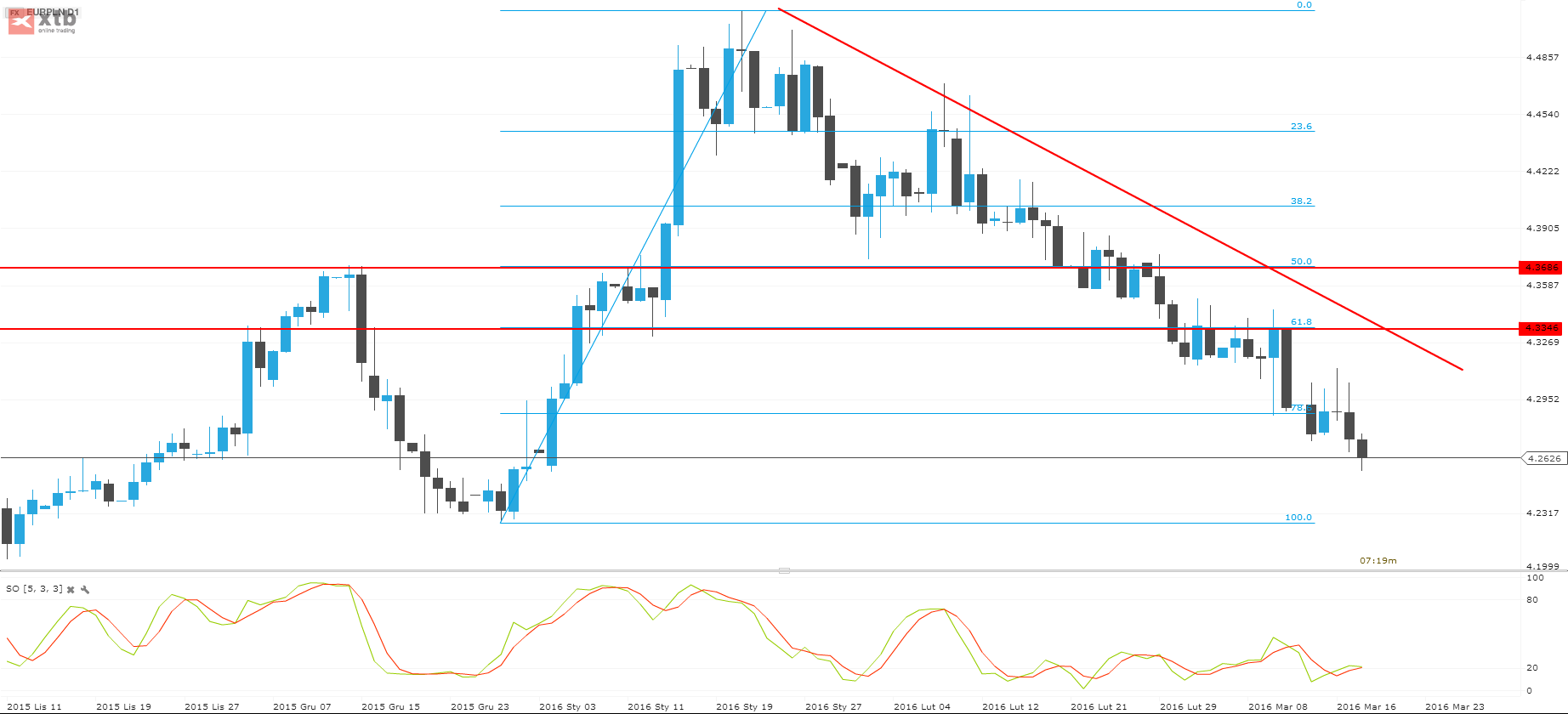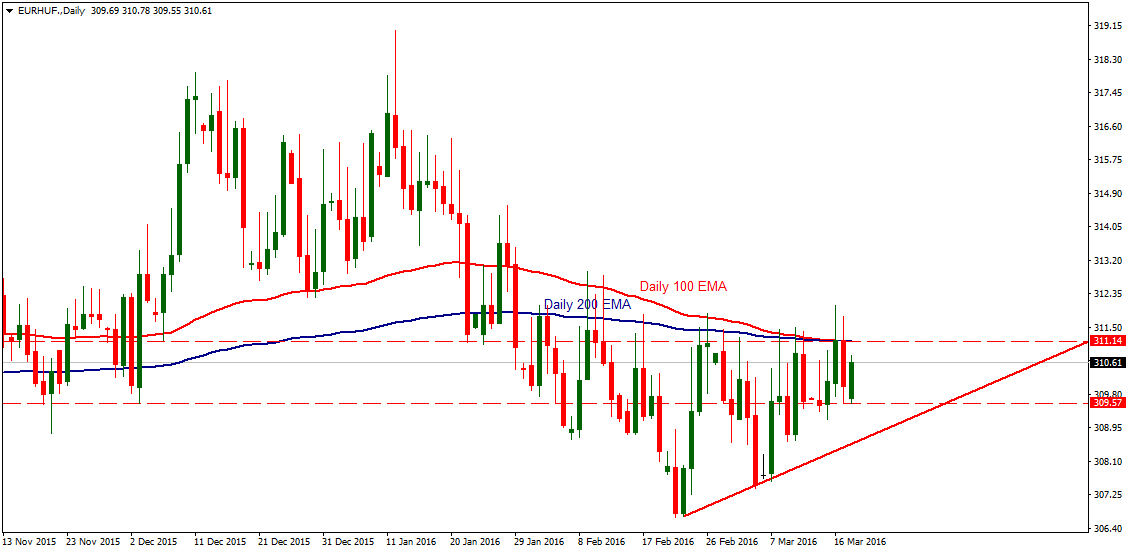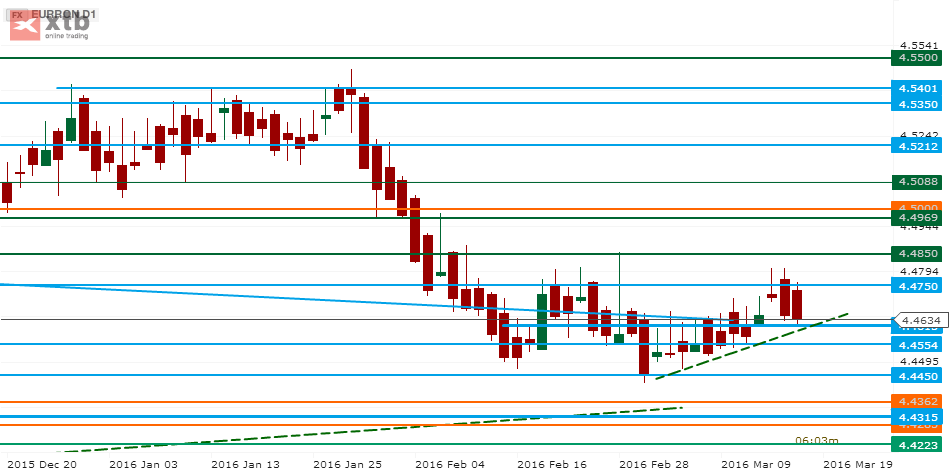This past week everybody was focused on the Fed and indeed there was some action after it on the currency markets. The Zloty though remained rather stable. It seems trades have calmed down after all the negative signals about the future of the local economy. Most of them are worries about the government increasing the budget deficit and endangering the banking sector (by the so-called “Swiss Franc act” – financial aid for CHF troubled mortgage holders). To be honest, those fears are not gone. Also, this past weeks’ macro data was not positive either. CPI in February (yearly basis) stood at -0.8% while Core CPI at -0.1%, both numbers worse than expectation. So it seems deflation is not fading away. Average wages though increased by 3.9% in February (yearly basis). Industrial production picked up with a 6.7% increase last month while retails sales increased by 3.9%. Good news? They were good until the PPI reading for February came up at -1.4% (in February, again yearly basis). We are getting mixed macro data with the most important ones (CPI, PPI) showing that the economy is and will be struggling with inflation for some time. There are already voices from abroad that the MPC will cut interest rates twice this upcoming year by a total of 50bp. (from the current 1.5% level). Sure, current MPC members are more dovish than the previous ones, but such move would mean that the central bank agrees the outlook of the economy is not good and that it requires action (which would be the opposite of what MPC members have been saying in the media recently). Despite all this, the volatility on the PLN market is lower than on the major currency pairs.
The EUR/PLN has been in a downward trend since the beginning of February and there are no signals this will change. We see on the daily chart that the PLN finished strong the previous week dropping below the 4.30 level. This past week it remained stable and traded in the 4.27 – 4.30 range. The stochastic oscillator remains in the lower levels suggesting the market is oversold and that an upward corrective move could be expected. If so, the EUR/PLN could be heading to this past week’s highs of 4.32. On the other hand though, there are no strong supports ahead and the way to lower levels is open. If the market finishes the week below the local support of 4.26, it is possible it will be attacking December 2015 lows of 4.23.

Hungarian Forint (EUR/HUF) – The situation has not changed
Although this week was shorter due to a national holiday in Hungary, there were a number of key events that had an effect on the market. Globally, those included The Federal Reserve and the Swiss National Bank meetings or the Bank of England rate decision on Thursday. However, what is even more important locally, Standard & Poor’s is set to release its update on Hungary’s debt rating today after market close. Probably, a rating upgrade is untimely yet and analysts expect Fitch Ratings to be the first to move Hungarian debt back to investment grade in May. Anyways, the bond market is still massive in the country. According to the most recent news, Hungary’s Government Debt Management Agency (ÁKK) sold HUF 64 billion worth of bonds on Thursday, instead of the originally planned HUF 50 billion.
The Forint traded at 310.57 to the euro a little before 7:00 in the evening on Thursday, firming from 312.00 late Wednesday. The price is still moving in a range between 309 and 311. We are a little bearish if the EUR/HUF remains below the 100 and 200 day moving averages. These indicators have been leading the currency pair so far.

Romanian Leu (EUR/RON) – Tense equilibrium
Romania is in the pole position to increase rates within the region, the Governor suggested, as inflation will rebound significantly from the current undershooting (it was at -2.68% in Feb y/y). The current projections see an overshooting past 3% in the first half of 2017, given the large fiscal stimulus provided by the government and the decay of negative basis effects after the cuts in VAT. This would not happen for a few quarters, but the official view is that we have reached the floor. rates on the interbank market have also moved higher, only just. Macro data was not bad: current account surplus of 0.16 bn. EUR in January (this is aligned with the seasonal patterns) and a decrease in total external debt by 1.2 bn. to 89.7 bn. EUR. Retail sales jumped by 2.4% and construction output by 8.8% y/y in January. However, the RON has not been flying high. The current equilibrium seems actually quite uncertain, and depreciating pressure alive and well. It could be the result of a not-so-convincing ECB message or, more likely, the hot debate surrounding the new bank law. Which could further limit the upside (otherwise, well deserved) of the RON.
In the technical perspective, we can choose our horizon: an uptrend over the last days.. or a side movement over the last few weeks. We have not seen convincing proof of the market willing to go either way. For now, the 4.46 support is decent, followed by 4.4450 in the event of a breakout. Which we see possible, but not necessarily right away. Resistance is at 4.4750 and 4.4850.

X-Trade Brokers Dom Maklerski S.A. does not take responsibility for investment decisions made under the influence of the information published on this website. None of the published information can be treated as a recommendation, disposition, promise, or guarantee that the investor will achieve a profit or will minimize risk using the information published on this website. Transactions including investment instruments, especially derivatives using leverage, are in its nature speculative and can provide both profits and losses that can exceed the initial deposit engaged by the investor.
Recommended Content
Editors’ Picks
EUR/USD edges lower toward 1.0700 post-US PCE

EUR/USD stays under modest bearish pressure but manages to hold above 1.0700 in the American session on Friday. The US Dollar (USD) gathers strength against its rivals after the stronger-than-forecast PCE inflation data, not allowing the pair to gain traction.
GBP/USD retreats to 1.2500 on renewed USD strength

GBP/USD lost its traction and turned negative on the day near 1.2500. Following the stronger-than-expected PCE inflation readings from the US, the USD stays resilient and makes it difficult for the pair to gather recovery momentum.
Gold struggles to hold above $2,350 following US inflation

Gold turned south and declined toward $2,340, erasing a large portion of its daily gains, as the USD benefited from PCE inflation data. The benchmark 10-year US yield, however, stays in negative territory and helps XAU/USD limit its losses.
Bitcoin Weekly Forecast: BTC’s next breakout could propel it to $80,000 Premium

Bitcoin’s recent price consolidation could be nearing its end as technical indicators and on-chain metrics suggest a potential upward breakout. However, this move would not be straightforward and could punish impatient investors.
Week ahead – Hawkish risk as Fed and NFP on tap, Eurozone data eyed too

Fed meets on Wednesday as US inflation stays elevated. Will Friday’s jobs report bring relief or more angst for the markets? Eurozone flash GDP and CPI numbers in focus for the Euro.